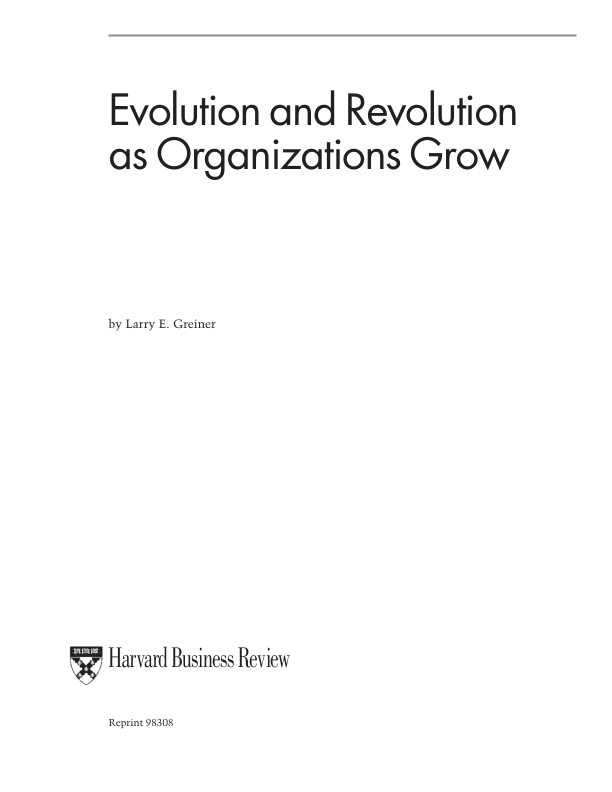
Metadata
- Author: Larry E. Greiner
- Full Title:: Evolution and Revolution as Organizations Grow
- Category:: 🗞️Articles
- Document Tags:: company culture, Company culture,
- URL:: https://readwise.io/reader/document_raw_content/62197149
- Read date:: 2025-06-29
Highlights
No me ha gustado nada… cero referencias a estudios, unas fases poco claras…
EVOLUTION AND REVOLUTION AS ORGANIZATIONS GROW (View Highlight)
as the company grows, those very activities become the problem. Larger production runs require knowledge about the efficiencies of manufacturing. (View Highlight)
The new manager and his or her key supervisors assume most of the responsibility for instituting direction; lower-level supervisors are treated more as functional specialists than as auton (View Highlight)
Although the new directive techniques channel employees’ energy more efficiently into growth, they eventually become inappropriate for controlling a more diverse and complex organization. Lower-level employees find themselves restricted by a cumbersome and centralized hierarchy. They have come to possess more direct knowledge about markets and machinery than do their leaders at the top (View Highlight)
At this point, a crisis of leadership occurs, which is the onset of the first revolution. Who will lead the company out of confusion and solve the managerial problems confronting it? Obviously, a strong manager is needed – one who has the necessary knowledge and skills to introduce new business techniques. (View Highlight)
Thus, the second revolution emerges from a crisis of autonomy. The solution adopted by most companies is to move toward more delegation. Yet it is difficult for top-level managers who previously were successful at being directive to give up responsibility to lower-level managers (View Highlight)
Phase 1: Creativity (View Highlight)
Phase 3: Delegation (View Highlight)
Phase 2: Direction (View Highlight)
the use of formal systems for achieving greater coordination and by top-level executives taking responsibility for the initiation and administration of these new systems. (View Highlight)
Phase 5: Collaboration (View Highlight)
Formal planning procedures are established and intensively reviewed. (View Highlight)
The Phase 5 evolution, then, builds around a more flexible and behavioral approach to management (View Highlight)
A matrix-type structure is frequently used to assemble the right teams for the appropriate problems. (View Highlight)
A serious problem eventually emerges, however, as top-level executives sense that they are losing control over a highly diversified field operation. Autonomous field managers prefer to run their own shows without coordinating plans, money, technology, and personnel with the rest of the organization. Freedom breeds a parochial attitude. Soon, the organization falls into a crisis of control (View Highlight)
Some topmanagement teams attempt a return to centralized management, which usually fails because of the organization’s newly vast scope of operations. Those companies that move ahead find a new solution in the use of special coordination techniques. (View Highlight)
Phase 4: Coordination (View Highlight)
A red-tape crisis is in full swing. Line managers, for example, increasingly resent direction from those who are not familiar with local conditions. And staff people, for their part, complain about uncooperative and uninformed line managers. Together, both groups criticize the bureaucratic system that has evolved. Procedures take precedence over problem solving (View Highlight)
imagine that the revolution arising from the “?” crisis will center around the psychological saturation of employees who grow emotionally and physically exhausted from the intensity of teamwork and the heavy pressure for innovative solutions. My hunch is that the Phase 5 revolution will be solved through new structures and programs that allow employees to periodically rest, reflect, and revitalize themselves. (View Highlight)
I wrote the article mainly about industrial and consumer goods companies, not about knowledge organizations or service businesses, which had yet to come into prominence. (View Highlight)